2006 MERCEDES-BENZ SPRINTER engine
[x] Cancel search: enginePage 609 of 2305
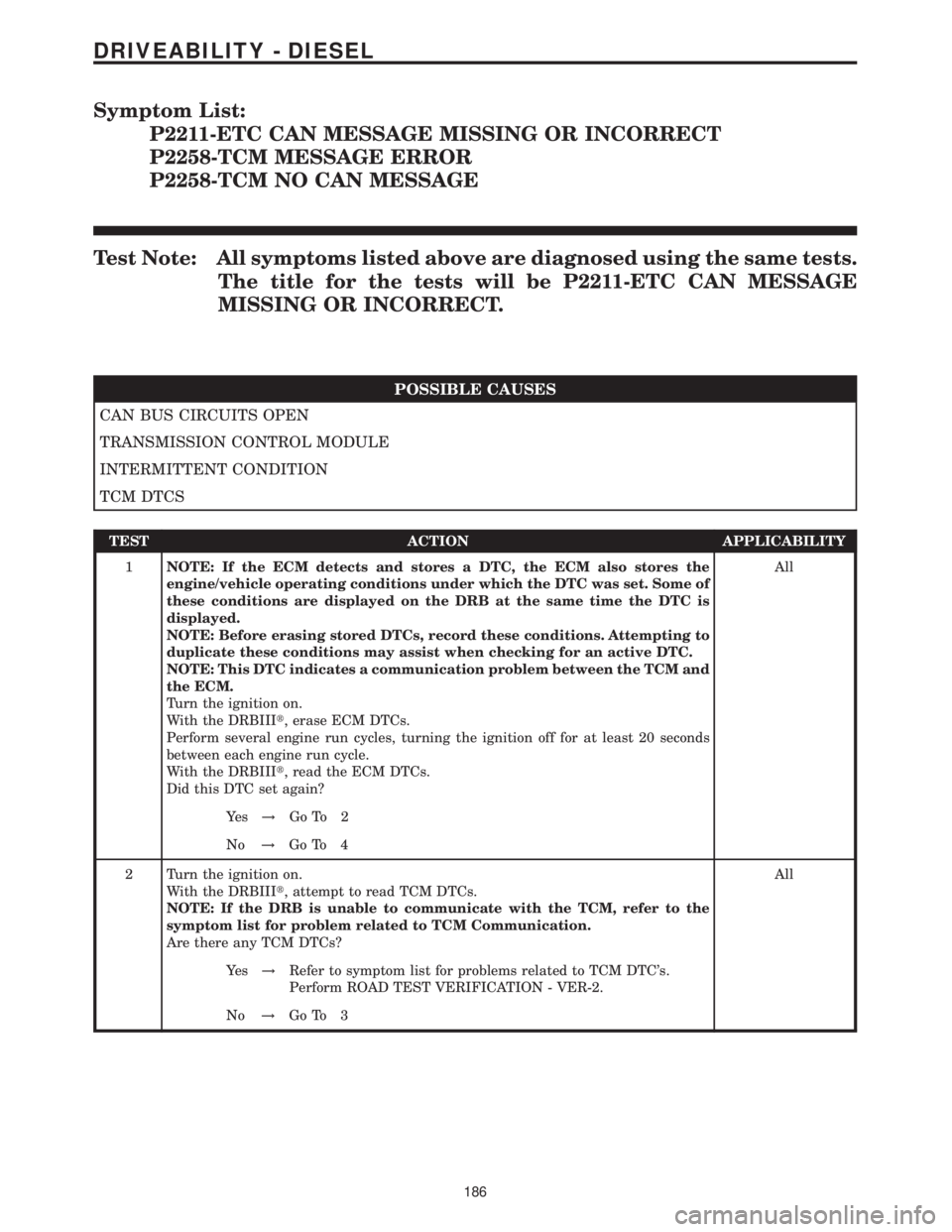
Symptom List:
P2211-ETC CAN MESSAGE MISSING OR INCORRECT
P2258-TCM MESSAGE ERROR
P2258-TCM NO CAN MESSAGE
Test Note: All symptoms listed above are diagnosed using the same tests.
The title for the tests will be P2211-ETC CAN MESSAGE
MISSING OR INCORRECT.
POSSIBLE CAUSES
CAN BUS CIRCUITS OPEN
TRANSMISSION CONTROL MODULE
INTERMITTENT CONDITION
TCM DTCS
TEST ACTION APPLICABILITY
1NOTE: If the ECM detects and stores a DTC, the ECM also stores the
engine/vehicle operating conditions under which the DTC was set. Some of
these conditions are displayed on the DRB at the same time the DTC is
displayed.
NOTE: Before erasing stored DTCs, record these conditions. Attempting to
duplicate these conditions may assist when checking for an active DTC.
NOTE: This DTC indicates a communication problem between the TCM and
the ECM.
Turn the ignition on.
With the DRBIIIt, erase ECM DTCs.
Perform several engine run cycles, turning the ignition off for at least 20 seconds
between each engine run cycle.
With the DRBIIIt, read the ECM DTCs.
Did this DTC set again?All
Ye s!Go To 2
No!Go To 4
2 Turn the ignition on.
With the DRBIIIt, attempt to read TCM DTCs.
NOTE: If the DRB is unable to communicate with the TCM, refer to the
symptom list for problem related to TCM Communication.
Are there any TCM DTCs?All
Ye s!Refer to symptom list for problems related to TCM DTC's.
Perform ROAD TEST VERIFICATION - VER-2.
No!Go To 3
186
DRIVEABILITY - DIESEL
Page 610 of 2305
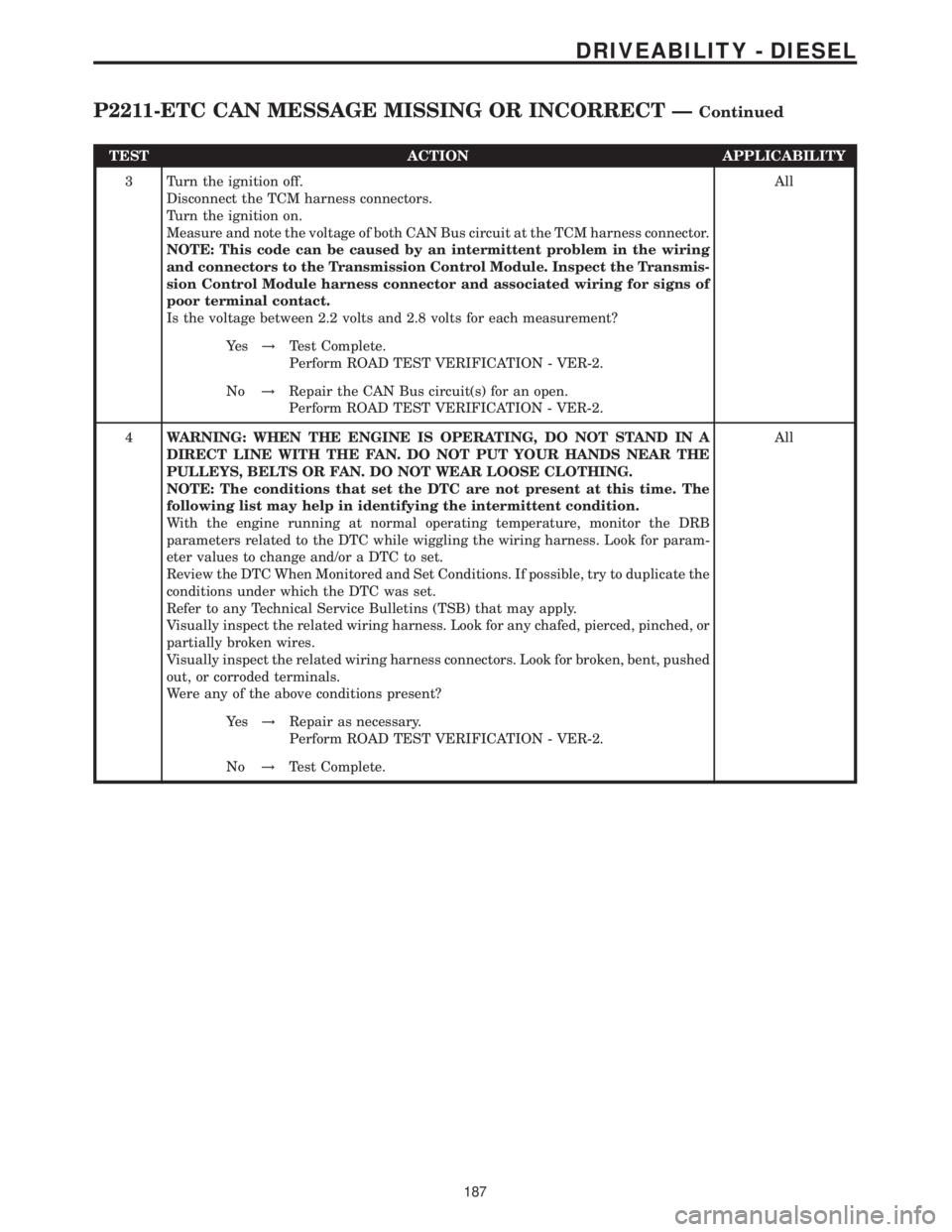
TEST ACTION APPLICABILITY
3 Turn the ignition off.
Disconnect the TCM harness connectors.
Turn the ignition on.
Measure and note the voltage of both CAN Bus circuit at the TCM harness connector.
NOTE: This code can be caused by an intermittent problem in the wiring
and connectors to the Transmission Control Module. Inspect the Transmis-
sion Control Module harness connector and associated wiring for signs of
poor terminal contact.
Is the voltage between 2.2 volts and 2.8 volts for each measurement?All
Ye s!Test Complete.
Perform ROAD TEST VERIFICATION - VER-2.
No!Repair the CAN Bus circuit(s) for an open.
Perform ROAD TEST VERIFICATION - VER-2.
4WARNING: WHEN THE ENGINE IS OPERATING, DO NOT STAND IN A
DIRECT LINE WITH THE FAN. DO NOT PUT YOUR HANDS NEAR THE
PULLEYS, BELTS OR FAN. DO NOT WEAR LOOSE CLOTHING.
NOTE: The conditions that set the DTC are not present at this time. The
following list may help in identifying the intermittent condition.
With the engine running at normal operating temperature, monitor the DRB
parameters related to the DTC while wiggling the wiring harness. Look for param-
eter values to change and/or a DTC to set.
Review the DTC When Monitored and Set Conditions. If possible, try to duplicate the
conditions under which the DTC was set.
Refer to any Technical Service Bulletins (TSB) that may apply.
Visually inspect the related wiring harness. Look for any chafed, pierced, pinched, or
partially broken wires.
Visually inspect the related wiring harness connectors. Look for broken, bent, pushed
out, or corroded terminals.
Were any of the above conditions present?All
Ye s!Repair as necessary.
Perform ROAD TEST VERIFICATION - VER-2.
No!Test Complete.
187
DRIVEABILITY - DIESEL
P2211-ETC CAN MESSAGE MISSING OR INCORRECT ÐContinued
Page 612 of 2305
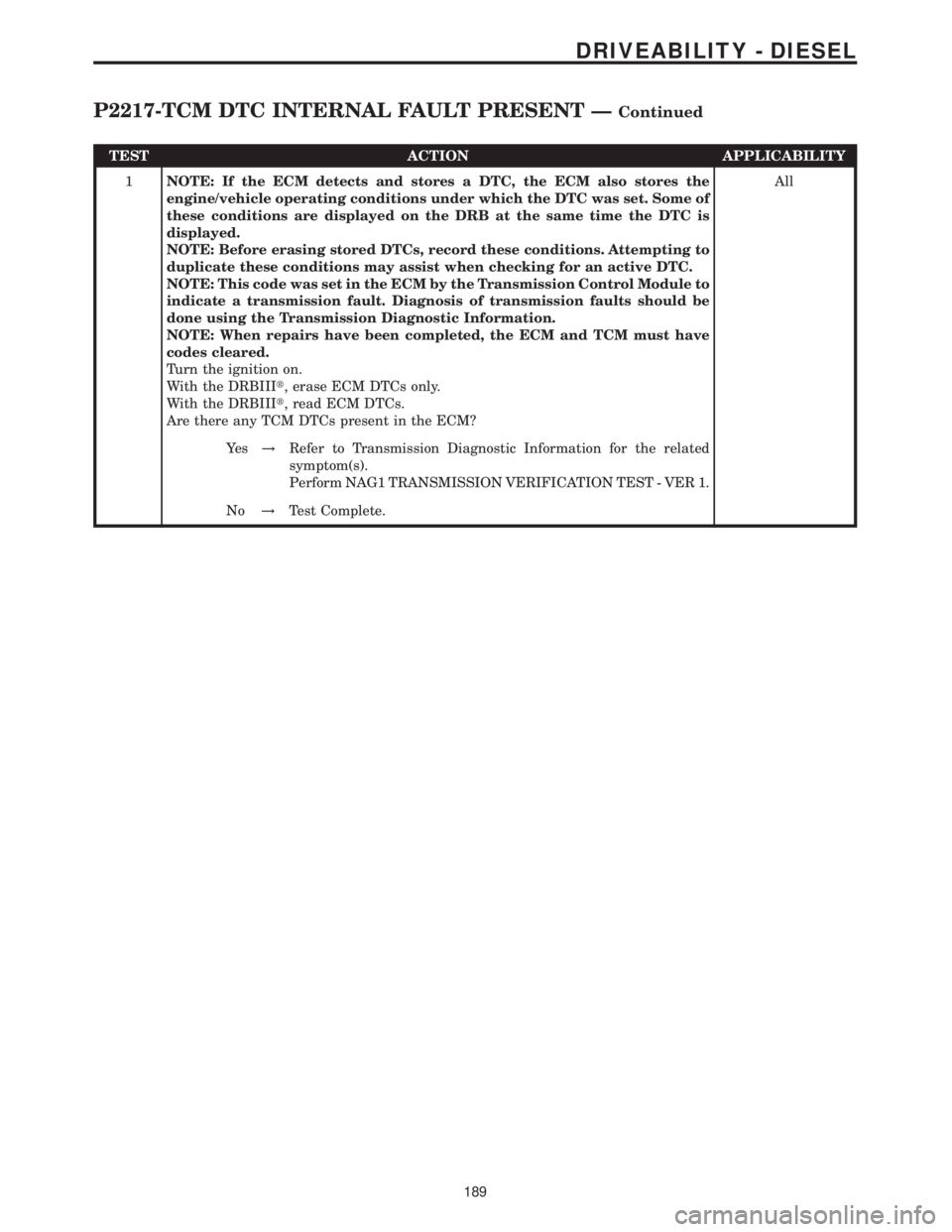
TEST ACTION APPLICABILITY
1NOTE: If the ECM detects and stores a DTC, the ECM also stores the
engine/vehicle operating conditions under which the DTC was set. Some of
these conditions are displayed on the DRB at the same time the DTC is
displayed.
NOTE: Before erasing stored DTCs, record these conditions. Attempting to
duplicate these conditions may assist when checking for an active DTC.
NOTE: This code was set in the ECM by the Transmission Control Module to
indicate a transmission fault. Diagnosis of transmission faults should be
done using the Transmission Diagnostic Information.
NOTE: When repairs have been completed, the ECM and TCM must have
codes cleared.
Turn the ignition on.
With the DRBIIIt, erase ECM DTCs only.
With the DRBIIIt, read ECM DTCs.
Are there any TCM DTCs present in the ECM?All
Ye s!Refer to Transmission Diagnostic Information for the related
symptom(s).
Perform NAG1 TRANSMISSION VERIFICATION TEST - VER 1.
No!Test Complete.
189
DRIVEABILITY - DIESEL
P2217-TCM DTC INTERNAL FAULT PRESENT ÐContinued
Page 613 of 2305

Symptom List:
P2240-ABS STEERING ANGLE SENSOR CAN MESSAGE IMPLAUSI-
BLE 1
P2240-ABS STEERING ANGLE SENSOR CAN MESSAGE IMPLAUSI-
BLE 2
Test Note: All symptoms listed above are diagnosed using the same tests.
The title for the tests will be P2240-ABS STEERING ANGLE
SENSOR CAN MESSAGE IMPLAUSIBLE 1.
POSSIBLE CAUSES
CAN BUS CIRCUITS OPEN
STEERING ANGLE SENSOR
INTERMITTENT CONDITION
TEST ACTION APPLICABILITY
1NOTE: If the ECM detects and stores a DTC, the ECM also stores the
engine/vehicle operating conditions under which the DTC was set. Some of
these conditions are displayed on the DRB at the same time the DTC is
displayed.
NOTE: Before erasing stored DTCs, record these conditions. Attempting to
duplicate these conditions may assist when checking for an active DTC.
NOTE: This DTC indicates a communication problem between the Steering
Angle Sensor and the ECM.
Turn the ignition on.
With the DRBIIIt, erase ECM DTCs.
Perform several engine run cycles, turning the ignition off for at least 20 seconds
between each engine run cycle.
With the DRBIIIt, read the ECM DTCs.
Did this DTC set again?All
Ye s!Go To 2
No!Go To 3
2 Turn the ignition off.
Disconnect the Steering Angle Sensor harness connector.
NOTE: This code can be caused by an intermittent problem in the wiring
and connectors to the Steering Angle Sensor. Inspect the Steering Angle
Sensor harness connector and associated wiring for signs of poor terminal
contact.
Turn the ignition on.
Measure and note the voltage of both CAN Bus circuit at the Steering Angle Sensor
harness connector.
Is the voltage between 2.2 volts and 2.8 volts for each measurement?All
Ye s!Test Complete.
Perform ROAD TEST VERIFICATION - VER-2.
No!Repair the CAN Bus circuit(s) for an open.
Perform ROAD TEST VERIFICATION - VER-2.
190
DRIVEABILITY - DIESEL
Page 614 of 2305

TEST ACTION APPLICABILITY
3WARNING: WHEN THE ENGINE IS OPERATING, DO NOT STAND IN A
DIRECT LINE WITH THE FAN. DO NOT PUT YOUR HANDS NEAR THE
PULLEYS, BELTS OR FAN. DO NOT WEAR LOOSE CLOTHING.
NOTE: The conditions that set the DTC are not present at this time. The
following list may help in identifying the intermittent condition.
With the engine running at normal operating temperature, monitor the DRB
parameters related to the DTC while wiggling the wiring harness. Look for param-
eter values to change and/or a DTC to set.
Review the DTC When Monitored and Set Conditions. If possible, try to duplicate the
conditions under which the DTC was set.
Refer to any Technical Service Bulletins (TSB) that may apply.
Visually inspect the related wiring harness. Look for any chafed, pierced, pinched, or
partially broken wires.
Visually inspect the related wiring harness connectors. Look for broken, bent, pushed
out, or corroded terminals.
Were any of the above conditions present?All
Ye s!Repair as necessary.
Perform ROAD TEST VERIFICATION - VER-2.
No!Test Complete.
191
DRIVEABILITY - DIESEL
P2240-ABS STEERING ANGLE SENSOR CAN MESSAGE IMPLAUSIBLE 1
Ð
Continued
Page 617 of 2305
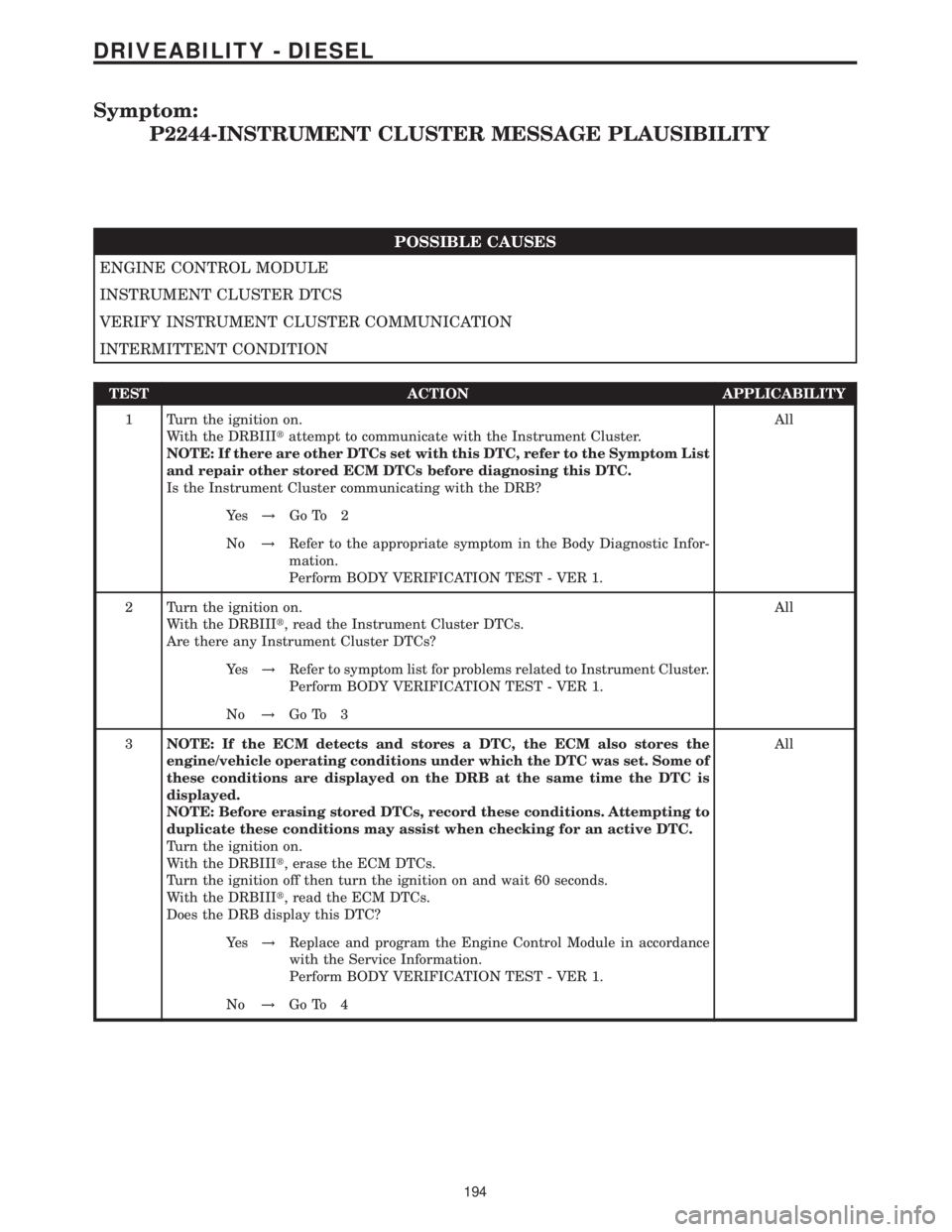
Symptom:
P2244-INSTRUMENT CLUSTER MESSAGE PLAUSIBILITY
POSSIBLE CAUSES
ENGINE CONTROL MODULE
INSTRUMENT CLUSTER DTCS
VERIFY INSTRUMENT CLUSTER COMMUNICATION
INTERMITTENT CONDITION
TEST ACTION APPLICABILITY
1 Turn the ignition on.
With the DRBIIItattempt to communicate with the Instrument Cluster.
NOTE: If there are other DTCs set with this DTC, refer to the Symptom List
and repair other stored ECM DTCs before diagnosing this DTC.
Is the Instrument Cluster communicating with the DRB?All
Ye s!Go To 2
No!Refer to the appropriate symptom in the Body Diagnostic Infor-
mation.
Perform BODY VERIFICATION TEST - VER 1.
2 Turn the ignition on.
With the DRBIIIt, read the Instrument Cluster DTCs.
Are there any Instrument Cluster DTCs?All
Ye s!Refer to symptom list for problems related to Instrument Cluster.
Perform BODY VERIFICATION TEST - VER 1.
No!Go To 3
3NOTE: If the ECM detects and stores a DTC, the ECM also stores the
engine/vehicle operating conditions under which the DTC was set. Some of
these conditions are displayed on the DRB at the same time the DTC is
displayed.
NOTE: Before erasing stored DTCs, record these conditions. Attempting to
duplicate these conditions may assist when checking for an active DTC.
Turn the ignition on.
With the DRBIIIt, erase the ECM DTCs.
Turn the ignition off then turn the ignition on and wait 60 seconds.
With the DRBIIIt, read the ECM DTCs.
Does the DRB display this DTC?All
Ye s!Replace and program the Engine Control Module in accordance
with the Service Information.
Perform BODY VERIFICATION TEST - VER 1.
No!Go To 4
194
DRIVEABILITY - DIESEL
Page 618 of 2305
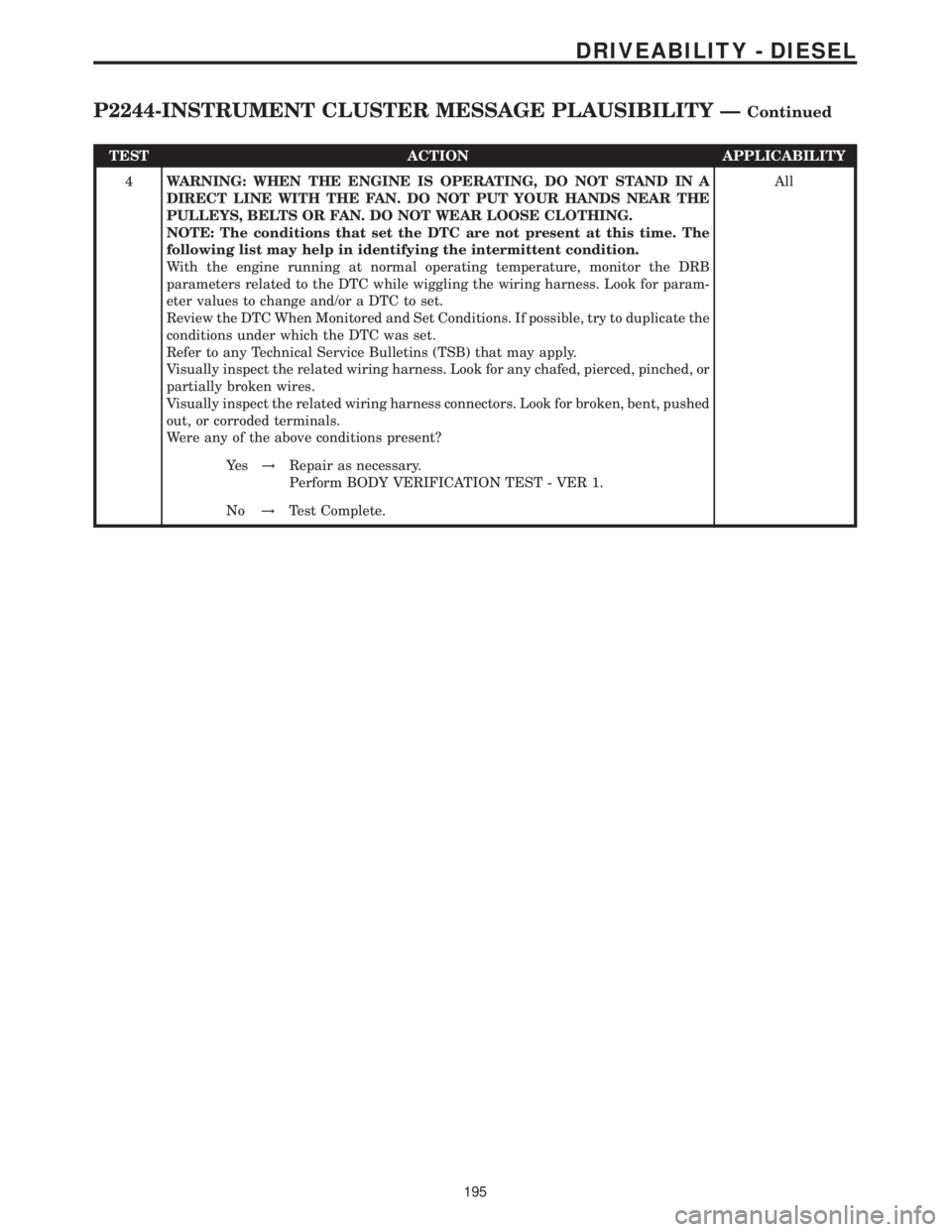
TEST ACTION APPLICABILITY
4WARNING: WHEN THE ENGINE IS OPERATING, DO NOT STAND IN A
DIRECT LINE WITH THE FAN. DO NOT PUT YOUR HANDS NEAR THE
PULLEYS, BELTS OR FAN. DO NOT WEAR LOOSE CLOTHING.
NOTE: The conditions that set the DTC are not present at this time. The
following list may help in identifying the intermittent condition.
With the engine running at normal operating temperature, monitor the DRB
parameters related to the DTC while wiggling the wiring harness. Look for param-
eter values to change and/or a DTC to set.
Review the DTC When Monitored and Set Conditions. If possible, try to duplicate the
conditions under which the DTC was set.
Refer to any Technical Service Bulletins (TSB) that may apply.
Visually inspect the related wiring harness. Look for any chafed, pierced, pinched, or
partially broken wires.
Visually inspect the related wiring harness connectors. Look for broken, bent, pushed
out, or corroded terminals.
Were any of the above conditions present?All
Ye s!Repair as necessary.
Perform BODY VERIFICATION TEST - VER 1.
No!Test Complete.
195
DRIVEABILITY - DIESEL
P2244-INSTRUMENT CLUSTER MESSAGE PLAUSIBILITY ÐContinued
Page 621 of 2305

Symptom:
P2306-SENSOR SUPPLY 2 VOLTAGE IS TOO HIGH
POSSIBLE CAUSES
BOOST PRESSURE SENSOR
FUEL PRESSURE SENSOR
VISUAL WIRING AND CONNECTOR INSPECTION
INTERMITTENT CONDITION
SENSOR SUPPLY VOLTAGE 2 SHORTED TO VOLTAGE
ENGINE CONTROL MODULE
TEST ACTION APPLICABILITY
1NOTE: If the ECM detects and stores a DTC, the ECM also stores the
engine/vehicle operating conditions under which the DTC was set. Some of
these conditions are displayed on the DRB at the same time the DTC is
displayed.
NOTE: Before erasing stored DTCs, record these conditions. Attempting to
duplicate these conditions may assist when checking for an active DTC.
Turn the ignition on.
With the DRB, erase ECM DTCs.
Turn the ignition off for 10 seconds.
Start the engine.
Monitor the DRB for ECM DTCs.
Did this DTC set again?All
Ye s!Go To 2
No!Go To 6
2 Turn the ignition off.
Visually inspect the wiring and connectors associated with the Boost Pressure Sensor
and Fuel Pressure Sensor for problems that may result in a short circuit.
Were any problems found?All
Ye s!Repair or replace wiring/connectors as necessary.
Perform ROAD TEST VERIFICATION - VER-2.
No!Go To 3
3 Turn the ignition off.
Disconnect the Boost Pressure Sensor and Fuel Pressure Sensor harness connectors.
Disconnect the ECM harness connectors.
Remove the Engine Control Relay.
Connect a jumper wire between cavity 30 and cavity 87 of the Engine Control Relay
connector in Fuse Block No.1.
Turn the ignition on.
Measure the voltage at all circuits in the Fuel Pressure Sensor and Boost Pressure
Sensor harness connector cavities.
Is the voltage above 1.0 volt for any of the measurements?All
Ye s!Repair the circuit(s) that measured above 1.0 volt for a short to
voltage.
Perform ROAD TEST VERIFICATION - VER-2.
No!Go To 4
198
DRIVEABILITY - DIESEL